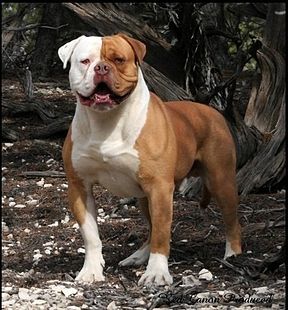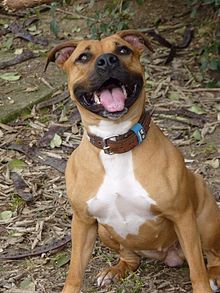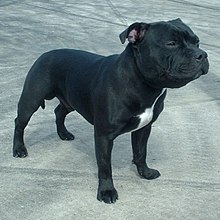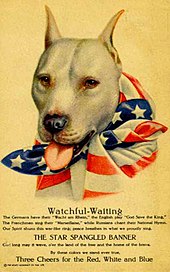Four of the over 30 breeds that breed specific legislation proponents refer to as "pit bulls" which isn't a breed but a legal "definition" used when attempting to enforce Breed bans.
There seems to be some confusion among them so I hope this helps.
American Pit Bull Terrier
The Pit Bull Terrier was created by breeding Old English Terriersand Old English Bulldogs together to produce a dog that combined the gameness of the terrier with the strength and athleticism of the bulldog.[4] These dogs were bred in England, and arrived in the United States where they became the direct ancestors of the American Pitbull Terrier. In the United Kingdom, pit bulls were used in bloodsports such as bull baiting, bear baiting. These bloodsports were officially eliminated in 1835 as Britain began to introduce animal welfare laws. Since dogfights were cheaper to organise and far easier to conceal from the law than bull or bear baits, bloodsport proponents turned to pitting their dogs against each other instead. Dog fighting was used as both a bloodsport (often involving gambling) and a way to continue to test the quality of their stock. For decades afterwards, dog fighting clandestinely took place in small areas of Britain and America. In the early 20th century, pitbulls were used as catch dogs in America for semi-wild cattle and hogs, to hunt, and drive livestock, and as family companions.[4] Some have been selectively bred for their fighting prowess.[5][6]
Pit Bull Terriers successfully fill the role of companion dogs, and police dogs,[7][8] andtherapy dog.[9] Pit Bull Terriers also constitute the majority of dogs used for illegal dog fighting in America[10] In addition, law enforcement organisations report these dogs are used for other nefarious purposes, such as guarding illegal narcotics operations,[11][12]use against police,[13] and as attack dogs.[14]
In an effort to counter the fighting reputation of pit bull-type dogs, in 1996 the San Francisco Society for the Prevention of Cruelty to Animals renamed pit bull terriers to "St. Francis Terriers", so that people might be more likely to adopt them.[15] 60 temperament-screened dogs were adopted until the program was halted, after several of the newly adopted pit bulls killed cats.[16] The New York City Center for Animal Care and Controltried a similar approach in 2004, relabeling their pit bulls as "New Yorkies", but dropped the idea in the face of overwhelming public opposition.[17][18]
American Bulldog
The American Bulldog is a breed of working dog. The names associated with the Bully and Standard types are those of the breeders who were influential in developing them, John D. Johnson (Bully) and Alan Scott (Standard).
 | |||||||||||||||||||||||||||||||||
| Origin | United States of America | ||||||||||||||||||||||||||||||||
|---|---|---|---|---|---|---|---|---|---|---|---|---|---|---|---|---|---|---|---|---|---|---|---|---|---|---|---|---|---|---|---|---|---|
| |||||||||||||||||||||||||||||||||
| |||||||||||||||||||||||||||||||||
| Domestic dog (Canis lupus familiaris) | |||||||||||||||||||||||||||||||||
Appearance[edit]
The American bulldog is a stocky, well built, strong-looking dog, with a large head and a muscular build. Its coat is short and generally smooth. The breed is a light to moderate shedder; however, they should be brushed on regular basis. Colors, while historically predominantly white with patches of red, black, or brindle, have grown in recent years to include many color patterns including black, red, brown, fawn, and all shades of brindle. The color conformation is quite varied, but solid black or any degree of merle is considered a cosmetic fault, and a blue color is a disqualification by the NKC Breed Standard. Black pigmentation on the nose and eye rims is preferred, with only some pink allowed. Eye color is usually brown, but heterochromia also occurs, although considered a cosmetic fault. American Bulldogs can be droolers; this varies and is more prevalent in the Bully type, which is generally a larger, heavier dog with a shorter muzzle. Standard or Performance types are generally more athletic with longer muzzles and a more square head. It is important to note that many modern American Bulldogs are a combination of the two types usually termed "hybrid." In general, American Bulldogs weigh between 27 to 54 kg (60 to 120 lb) and are 52 to 70 cm (20 to 28 in) at the withers, but have been known to greatly exceed these dimensions, especially in the "out of standard," nonworking stock.
History[edit]
History in Spain and England[edit]
Even the slight modifications the bulldog underwent in Spain and England up to the Industrial Revolution (before 1835), were absent in the working strains. Most settlers of the American South came from the West Midlands of England and emigrated as a result of the Civil War between Royalists and Parliamentarians, well before the Industrial Revolution).
History in the United States[edit]
The Old English Bulldog was preserved by working class immigrants who brought their working dogs with them to the American South. Small farmers and ranchers used this all-around working dog for many tasks including farm guardians, stock dogs and catch dog. These dogs were not an actual breed as considered by today's standards but were a generic bulldog type. There were no recorded pedigrees or records and breeding decisions were dependent on the best working farm dogs despite breed or background. Several separate strains of the "bulldog" type dogs were kept by ranchers as utilitarian working dogs.
Perhaps the most important role of the bulldog and the reason for its survival, and in fact why it thrived throughout the South, was because of the presence of feral pigs, introduced to the New World and without predators. The bulldogs were the settlers' only means of sufficiently dealing with the vermin. By World War II, the breed was near extinction until John D. Johnson and his father scoured the back roads of the South looking for the best specimens to revive the breed. During this time a young Alan Scott grew an interest in Johnson's dogs and began to work with him on the revitalization process. At some point, Alan Scott began infusing non-Johnson catch bulldogs from working Southern farms with John D. Johnson's line, creating the now Standard American Bulldog. At another point, Johnson began crossing his line with an atavistic English bulldog from the North that had maintained its genetic athletic vigor.
Recent history[edit]
American bulldogs are now safe from extinction and are enjoying a healthy increase in popularity, either as a working/protector dog or as a family pet. All over the world, they are used variously as "hog dogs" (catching escaped pigs or hunting razorbacks), as cattle drovers and as working or sport K-9s. American Bulldogs also successfully compete in several dog sports such as dog obedience, Schutzhund, French Ring,Mondio Ring, Iron Dog competition and weight pulling. They are also exhibited inconformation shows in the UKC, NKC, ABA, ABRA and the SACBR (South Africa).
American Staffordshire Terrier
The American Staffordshire Terrier, also known as Amstaff (in USA) or simplyStafford, is a medium-sized, short-coated American dog breed. It is one of several breeds commonly known as pit bulls.[2][3]In the early part of the twentieth century the breed gained social stature and was accepted by the American Kennel Club in 1936.[4] The name was changed to reflect difference from the Staffordshire Bull Terrier of England.
 | |||||||||||||||||||||
| Common nicknames | AmStaff Stafford | ||||||||||||||||||||
|---|---|---|---|---|---|---|---|---|---|---|---|---|---|---|---|---|---|---|---|---|---|
| Origin | United States | ||||||||||||||||||||
| |||||||||||||||||||||
| |||||||||||||||||||||
| Domestic dog (Canis lupus familiaris) | |||||||||||||||||||||
Origins...
Despite its name, the Staffordshire Terrier was first bred in the nineteenth century in Birmingham, West Midlands, rather than in the English county of Staffordshire where it was then later bred. The early ancestors of this breed came from England, where until the first part of the 19th century, theBulldog was bred in England. Bulldogs pictured as late as 1870 resemble contemporary American Staffordshire Terriers to a greater degree than present-day Bulldogs. Some writers contend it was the White English Terrier, Fox Terrier, or theBlack and Tan Terrier that was crossed with the Bulldog to develop the Staffordshire Terrier; all three breeds shared many traits, the greatest differences being in color, and spirit. The cross of Bulldog and Terrier was called by several names, including Bull-and-Terrier Dog, Pit Bull, or Half and Half.[5] Later, it assumed the name of Staffordshire Bull Terrier in England. These dogs began to find their way into America as early as 1870.
Staffordshire Bull Terrier
 | ||||||||||||||||||||||||||
| Common nicknames | Staffy Staffy Bull Staffy Dog Nanny Dog SBT[1] | |||||||||||||||||||||||||
|---|---|---|---|---|---|---|---|---|---|---|---|---|---|---|---|---|---|---|---|---|---|---|---|---|---|---|
| Origin | England | |||||||||||||||||||||||||
| ||||||||||||||||||||||||||
| ||||||||||||||||||||||||||
| Domestic dog (Canis lupus familiaris) | ||||||||||||||||||||||||||
The Staffordshire Bull Terrier is a medium-sized, short-coated breed of dog.[2]It is of English lineage, and is one of several breeds generally considered to be within the pit bull type.[3][4][5][6][7][8]
History.....
Before the 19th century, bloodsports such as bull baiting, bear baiting and cock fighting were common. Bulls brought to market were set upon by dogs as a way of tenderizing the meat and providing entertainment for the spectators; and dog fights with bears, bulls and other animals were often organised as entertainment for both royalty and commoners.
Early Bull and Terriers were not bred to resemble the companion animals of today, but for the characteristic known asgameness, with the pitting of dogs against bear or bull and exotic animals testing this attribute along with the strength and skill of the dog. Landrace working dogscrossbred with bulldogs provided the ancestral foundation stock for the Staffordshire Bull Terrier. This ancestor is traditionally known as a "Bull Terrier", believed to be around 200 years old by the time of the early 21st century, and is rather a class of races than a particular breed.
These bloodsports were officially eliminated in 1835 as Britain began to introduce animal welfare laws. Sincedogfights were cheaper to organise and far easier to conceal from the law than bull or bear baits, bloodsport proponents turned to pitting their dogs against each other instead. Dog fighting was used as both a bloodsport (often involving gambling) and a way to continue to test the quality of their stock. Clandestine dog fighting took place in pockets of Britain and America. Dogs were released into a pit, and the last dog still fighting (or occasionally, the last dog surviving) was recognised as the winner. The quality of pluckiness or "gameness" was highly prized; a dog that gave up during a fight was reviled as a cur.
As time went on the modern breed has become one with a temperament suitable for a pet and companion. It gained respectability, becoming a dog worthy to show, and was accepted by The Kennel Club of the United Kingdom as the Staffordshire Bull Terrier in 1935.[9]American bully
The American Bully breed developed as a natural extension of the American Pit Bull Terrier. The APBT has maintained a characteristic appearance and temperament for over 100 years. As with any long-standing breed, several types evolved from the parent breed, with one in particular taking on a specific build and structure that is so unique it was wise to recognize it as a different breed altogether. That being the American Bully breed.
The American Bully breed was subtly influenced by the infusion of several other breeds, which include the American Bulldog, English Bulldog, and Olde English Bulldogge.
The American Bully breed was recognized by the United Kennel Club on July 15, 2013.
Source.....
Wikipedia Dog
Well hopefully a little bit of legitimate information will prevent them embarrassing themselves with posts like this one below.....
more to come.....






No comments:
Post a Comment